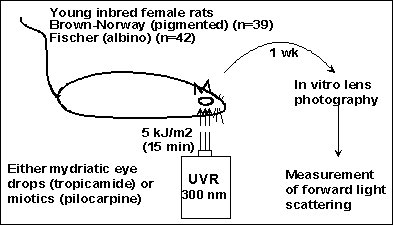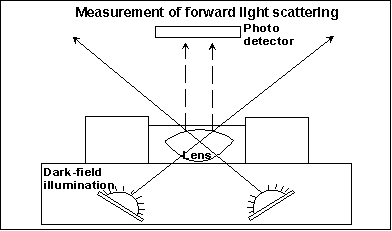Does eye pigment and small pupil size protect against UVR cataract?
Stefan Löfgren, Ralph Michael, Marcelo Ayala & Per G Söderberg
Poster submitted to the "Protection Against the Hazards of UVR" Internet conference Jan 1999
This study exhibits new data on experimental UVR cataract. At the same time, new questions arised. We have focussed the discussion to the parts where no answers really exist. We would like to hear the readers comments about the results and the speculation in the discussion.
Abstract
Purpose. To investigate the effect of pupil size and eye pigment on ultraviolet
radiation (UVR) induced cataract.
Methods. 39 Brown Norway rats (pigmented) and 42 Fischer-344 rats (albino) were
unilaterally exposed in vivo to UVR-300 nm. The dose incident on the cornea was 5
kJ/m2. Each strain was split into two groups which received either mydriatic
(pupil-dilating) or miotic (pupil-constricting) eye drops. One week after exposure the
lenses were extracted, photographed and the degree of forward light scattering (cataract)
was measured. The degree of externally visible ocular inflammation was estimated before
the eyes were taken out.
Results. Preliminary data analysis showed that all groups except the miotic-treated
pigmented rats developed pathologic light scattering. Albino rats were more sensitive to
UVR than the pigmented rats. Albino rats with small pupils developed more severe cataract
than with large pupils(!).
Conclusions. Larger pupil size does not increase the UVR lens damage. Pigmented
eyes protect against UV radiation, no matter the pupil size.
Introduction
Cataract is a major cause of blindness in the world. The surgical treatment of cataract where the lens is replaced by a artificial lens is very costful for the society. Scientists are trying to find the cause of cataract and possible medical treatments or preventive measures. Several hypotheses have been put through, among them the hypothesis that UVR in sunlight is an important risk factor for development of cataract. Epidemiological studies have shown a link between exposure to UV-B radiation in sunlight and development of cataract. Experimental studies confirm that UVR induces cataract. The safety levels for UVR exposure today are based on experiments with animals. Many studies use pupil-dilating eye drops in order to increase the "free" lens area exposed to the UVR or to reduce the variation in pupil size during the exposure. Little is however known about the effect of eye pigment and pupil size in the development of experimental UVR cataract. In this study these factors are investigated in a rat model.
Material
 |
Anaesthetized pigmented and albino rats were exposed in vivo to UV-B radiation. The UVR source was a mercury lamp with water filter and a double monochromator set to 300 nm and 9 nm full bandwidth at half maximum. The dose, measured at corneal level, was 5 kJ/m2. Exposure time was 15 minutes. One eye in each rat was irradiated. Before the irradiation half of the rats in each strain received either pupil-dilating or pupil-constricting eye drops. One week after exposure the degree of ocular inflammation was determined and the amount of forward light scattering was determined. |
 |
The lens was put in a cuvette filled with salt solution. The probing light from the dark-field illumination will in the case of a perfectly transparent lens pass through the lens and not reach the photo detector. If there are scattering centers in the lens, the probing light will scatter and reach the photo detector. |
Results
Preliminary data analysis shows that
| All groups except the miotic-treated pigmented rats developed pathologic light scattering. | |
| Albino rats were more sensitive to UVR than the pigmented rats. | |
| Albino rats with small pupils developed more severe cataract than with large pupils(!). | |
| There was no difference between the two pigmented groups. | |
| There was no difference between the control lenses in the four groups. | |
| Most cataracts were located equatorially with extension to the posterior. | |
| There was no large difference in ocular inflammation between the two groups within each strain (as seen by the observers naked eye). |
Discussion
The finding that pigmented eyes protects more against UVR than albino eyes is not very surprising since pigmented iris absorbs more UVR than albino iris. One cannot, however, rule out the possibility of an inherent difference in UVR sensitivity between the two rat strains, independent of the eye pigment. More intriguing is it that there was no significant difference between small and large pupil in the pigmented animals.We attribute this to the fact that the cell dividing area in the lens, the lens equator, is covered by the iris, even with maximally dilated pupil.
We were surprised to find that the albino animals with small pupil developed more severe cataract than the animals with large pupil. We speculate that this is due to increased intra-ocular inflammation which affects the lens. The external inspection of the general ocular inflammation did not exhibit any large differences between the two groups. This does, however, not exclude the possibility of a difference in intra-ocular inflammation.